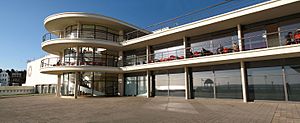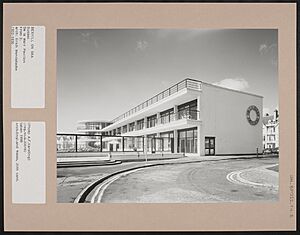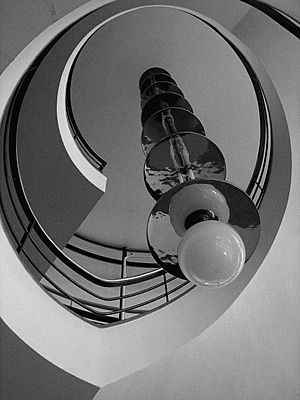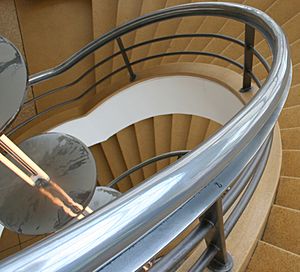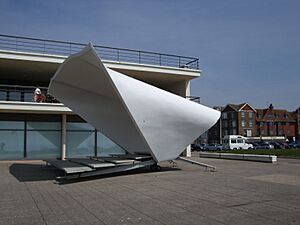De La Warr Pavilion facts for kids
The De La Warr Pavilion is a special building right on the seafront in Bexhill-on-Sea, East Sussex, England. It's so important that it's officially protected as a Grade I listed building.
This amazing building was designed by two architects, Erich Mendelsohn and Serge Chermayeff, and it was finished in 1935. It's known for its Modernist and International Style look. Some people even say it was the first big Modernist public building in Britain!
In 2005, after a lot of careful work to fix it up, the De La Warr Pavilion opened again. Now, it's a busy arts centre with one of the biggest art galleries on the south coast of England. Sadly, on February 18, 2022, a strong storm called Storm Eunice destroyed the bandstand that was added in the early 2000s.
Contents
Building History
The idea for this new building by the sea came from a design competition. This competition was started by Herbrand Sackville, 9th Earl De La Warr, and the building was named after him.
The 9th Earl was the Mayor of Bexhill and believed in helping everyone in society. He convinced the Bexhill council to build this public place. The competition was announced in February 1934. It asked for a hall for at least 1,500 people, a restaurant for 200, a reading room, and a lounge.
Designing the Pavilion
At first, the budget for the project was £50,000, but it later increased to £80,000. The competition was run by the Royal Institute of British Architects. Over 230 architects entered, and many of them used the Modernist style.
The architects chosen for the project were Erich Mendelsohn and Serge Chermayeff. They were very important in the Modern Movement in architecture. Their style, called the International Style, was perfect for the building. It used smooth, industrial-looking designs with large metal-framed windows. Instead of traditional bricks and stone, they used concrete and steel.
One of the most clever parts of the building was its use of a welded steel frame. This was a new idea at the time, developed by engineer Felix Samuely. Building the De La Warr Pavilion started in January 1935. The Duke and Duchess of York, who later became King George VI and Queen Elizabeth, officially opened the building on December 12, 1935.
The Pavilion During Wartime
During World War II, the De La Warr Pavilion was used by the military. Bexhill and the area around it were at risk if the Germans tried to invade. A famous comedian named Spike Milligan was one of the people who served at the pavilion during the war. The building had some small damage when a nearby hotel was bombed by German planes.
Restoring a Landmark
After the war, the local council took over managing the pavilion. In the 1970s and 1980s, some changes were made that didn't match the original design. Also, there wasn't enough money to keep the building in good shape, so it started to wear down. It was even used for indoor car boot sales, and its original signs disappeared.
In 1986, the De La Warr Pavilion was given Grade I listed building status. This meant it was protected from any more unsuitable changes. In 1989, a group called the Pavilion Trust was formed to help protect and restore the building. A writer named David Hare suggested it should become an art gallery.
In 2002, after a long process, the De La Warr Pavilion received £6 million from the Heritage Lottery Fund and the Arts Council of England. This money was for restoring the building and turning it into a modern arts centre. Work began in 2004. The building's ownership was also moved from the council to a charity called the De La Warr Pavilion Charitable Trust. On October 15, 2005, after 18 months of hard work, the De La Warr Pavilion officially reopened as a contemporary arts centre. It now has one of the largest galleries on the south coast of England.
Quotes About the Pavilion
It is the intention of the promoters that the building should be simple in design, and suitable for a holiday resort in the south of England. Character in design can be obtained by the use of large window spaces, terraces and canopies. No restriction as to style of architecture will be imposed but buildings must be simple, light in appearance and attractive, suitable for a Holiday Resort. Heavy stonework is not desirable [...] Modern steel framed or ferro-cement construction may be adopted.
People in Charge
Here are some of the people who have managed the De La Warr Pavilion:
- For Rother District Council:
- 1999–2011: Alan Haydon
- De La Warr Pavilion Charitable Trust:
- 2003–2011: Alan Haydon
- 2011–present: Stewart Drew
Special Supporters
These are some of the honorary patrons who support the De La Warr Pavilion:
- President: Camilla, Duchess of Cornwall
- Earl and Countess De La Warr
- Eddie Izzard
- Jill Theis
- Richard Sykes
- Antony Gormley
- Ivan Chermayeff
See also
 In Spanish: Pabellón De La Warr para niños
In Spanish: Pabellón De La Warr para niños
- Saltdean Lido
- Embassy Court


